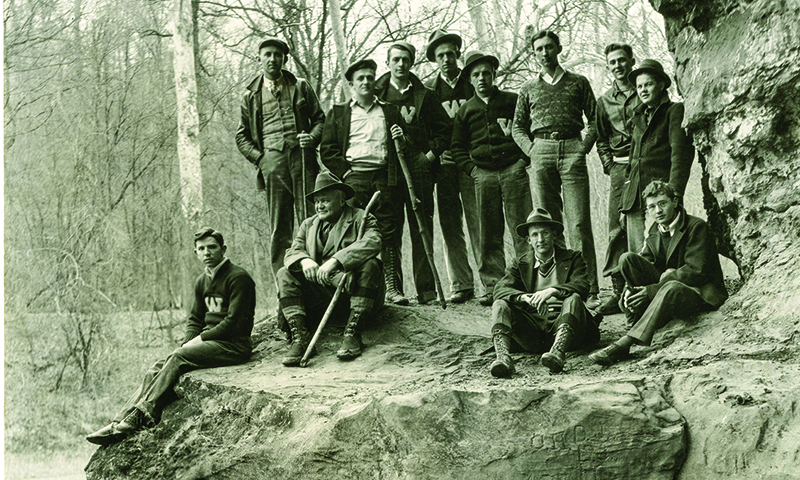The photograph was of a group of Wabash men standing on the edge of a rock face. On the back was written “Study Camp 1934, John G. Coulter—older man—center.” I had to know more! I discovered a treasure trove of Wabash history in the story of the senior study camps and the man who brought them to Wabash.
In 1929, a new face with a familiar name appeared on campus. President Louis Bertram Hopkins called on Dr. John G. Coulter [W1894] to return to Wabash as vice president. He was to further develop alumni relations and raise funds to celebrate the College’s centennial in 1932. Unfortunately, the Great Depression put a hold on fundraising. Coulter had to rethink how he could impact the campus community.
 Coulter did not have to look far for inspiration. His father, John Merle Coulter, and uncle, Stanley Coulter, grew up in Montgomery County and explored the hills and valleys of what would become Shades State Park and Turkey Run State Park. Their upbringing sparked in them a love and respect for nature and natural sciences. These early expeditions led his father to a distinguished career in the natural sciences. In 1871, John M. served as a member of the Hayden Geological Survey, which studied the land that became Yellowstone National Park. He joined the faculty of Wabash in 1879, leaving Wabash in 1891 to assume the presidency of Indiana University. He died in 1928, the year before John G. came to Wabash, but his father imparted a love of nature and the power it can play in the educational process.
Coulter did not have to look far for inspiration. His father, John Merle Coulter, and uncle, Stanley Coulter, grew up in Montgomery County and explored the hills and valleys of what would become Shades State Park and Turkey Run State Park. Their upbringing sparked in them a love and respect for nature and natural sciences. These early expeditions led his father to a distinguished career in the natural sciences. In 1871, John M. served as a member of the Hayden Geological Survey, which studied the land that became Yellowstone National Park. He joined the faculty of Wabash in 1879, leaving Wabash in 1891 to assume the presidency of Indiana University. He died in 1928, the year before John G. came to Wabash, but his father imparted a love of nature and the power it can play in the educational process.
For his camps, he proposed taking a selection of seniors to Turkey Run for one week to study and prepare their senior theses and final projects. Coulter described his proposal in an article in The Journal of Higher Education as “a return for a time to conditions like those in which the College began, an experience of scholastic life in surroundings such as the first student had. The students become familiar with a beautiful countryside of which the campus is the threshold.” Coulter mixed up the selected students to provide them with opportunities to get to know their fellow students and build a brotherhood outside the bounds of their fraternity houses, academic divisions, and sports teams.
At the first camp, students adhered to the following daily schedule: call at 6:45 a.m., breakfast at 7:15 a.m., study time 8:00 a.m.–noon, lunch at 12:30 p.m., study time 2–3 p.m., hike 3–5 p.m., study time 5:30–6:30 p.m., dinner at 6:30 p.m., and discussion 8–10 p.m. Students were encouraged, but not required, to attend all activities. This first group of students included future Wabash President Byron K. Trippet ’30, who described the experience as “a high point in his total undergraduate experience.”
Coulter’s experiment was judged a success, and for the next two years, he would continue to lead young men off the confines of campus to Turkey Run to study and commune with their classmates. Coulter left Wabash in 1932, but his study camps would continue, evolving and growing. Some of these changes included studying for senior comps, adding camps for sophomores, and opening up the experience to more students. The camps continued until the late 1950s, when they were discontinued due to changes in the curriculum, heavier requirements in coursework, and a lack of enthusiasm among the student body. In the spring of 1967, the graduating senior class tried to revive the tradition—39 students made the trek to Turkey Run. Further attempts have been made to bring back the camps. None have had the staying power of the initial program.